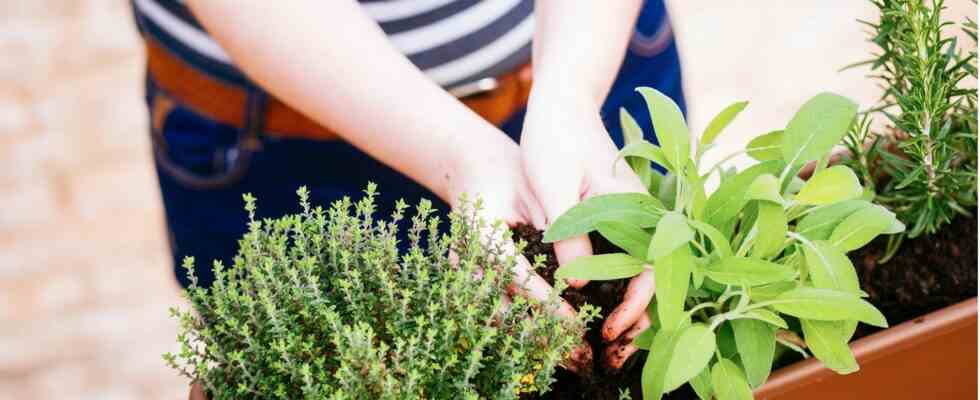Fresh Green
Planting herbs: This is how you can grow them on the balcony and windowsill
You can create your own herb garden in just a few simple steps
© martiapunts / Getty Images
Basil and parsley, rosemary and thyme are popular kitchen herbs that add flavor to a dish. Those who prefer their fresh aroma to dried spices can plant them themselves on the windowsill or on the balcony.
Having your own herb garden has the advantage that you can use fresh ingredients for cooking all year round. So that your green roommates feel comfortable at home and get along with their fellow species (some varieties are literally not green with each other), you should consider a few points before planting. These not only include the right location, but also the right watering intervals and care tips for herbs. In the following we will explain to you what needs to be considered when rearing.
Planting herbs: when, how and where?
Regardless of whether you use your herbs as seed buy and in one seed tray grow – or as a fully grown plant that you simply repot at home: In both cases, the right location is crucial for a high-yield harvest. The same applies to the time of rearing and the watering intervals. There is an explanation for this as follows.
When is the right time?
If you want to plant your herbs outside – on the balcony, on the terrace or in the garden – you should only start rearing them after the frost season. Say towards the end of April, beginning of May. This applies to pre-grown seedlings as well as to purchased pots. Heat-loving herbs such as marjoram or tarragon should be put out even later (end of May) when it is still too cold outside. If you want to keep your green ingredients indoors on a windowsill, you can grow them sooner.
How are herbs planted?
Poor soil is the best choice for most herbs, for this reason commercial potting soil is not recommended: it contains too many nutrients. More suitable for rearing here is special herbal soil in combination with something herbal fertilizer (use this sparingly). When repotting, proceed as follows: Water the root ball well before placing it in a suitable pot half filled with soil. Fill the container with soil, press it down lightly and water it.
Where is the best location?
Like many other plants, herbs usually prefer sunny or semi-shady places. There are also sensitive plants that feel better in the shade: for example mint and cress, rocket and sorrel. Classic kitchen herbs such as basil and rosemary, oregano and thyme, coriander and lemon balm prefer a sunny location. Chives and chervil, tarragon and parsley prefer semi-shade, i.e. a mixture of sunny and shady times.
Which herbs are (not) compatible?
In fact, not all herbs get along with each other because they prevent each other from growing – or have different preferences such as dry or moist soil. A tip here is not to plant annual varieties (basil, dill) with perennials (thyme, mint) in the same bed or in the same flower pot. Some herbs, on the other hand, do not get along with others, so they should be kept alone, such as lemon balm, sage or tarragon. Peppermint, tarragon, dill and coriander need a lot of space and therefore prefer to be planted in individual pots. These varieties, on the other hand, get along well with each other: parsley, cress, marjoram and chervil. Or this combination: chives, rosemary, sage and lemon balm.
In this table you will find a detailed overview again:
Herbs | get along | don’t get along |
basil | Oregano, Parsley, Rosemary | Mint, Lemon Balm |
dill | Cress, marjoram, parsley, chives | tarragon |
coriander | chili, ginger | parsley, chives |
marjoram | Dill, cress, parsley | thyme, oregano |
oregano | Basil, rosemary, chives, sage | marjoram |
Parsely | Basil, dill, cress, chives | coriander, mint |
mint | none | basil, thyme, parsley |
rosemary | Basil, oregano, sage, thyme | chives |
sage | Oregano, Thyme, Rosemary, Lemon Balm | basil |
thyme | Tarragon, rosemary, sage, lemon balm | marjoram, mint |
lemon balm | Sage, Chives, Thyme | basil |
Source: smarticular
How to properly water your herbs
Even if some herbs prefer moist soil, they still don’t like wet feet. In other words, you should only ever water your green flatmates in such a way that no water collects in the bottom of the flower pot. Sun worshipers, on the other hand, run the risk of drying out too quickly in the warm summer months. Pots made of clay or terracotta can store moisture better than plastic containers. Alternatively offer also self-watering herb pots on. Ideally, water your herbs no more than twice a week – parsley and chives more often. Incidentally, the best time to water is early in the morning or in the evening. Regular care also includes cutting off dried leaves or stems.
And another tip: If you want to use the leaves for cooking, cut them off in the morning: this is when herbs have the best aroma.
You might also be interested in:
This article contains so-called affiliate links. Further information are available here.


